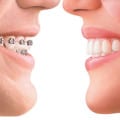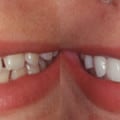Are Lingual Braces Painful? (7 Expert Answers)
Last Updated on September 22, 2021 by editor
Are lingual braces painful? Your choice to get braces is one of the most effective ways to improve the appearance of your smile. Yet, you may be worried about what it feels like to have brackets and wires placed across your teeth. You may have even heard a friend complain about discomfort when they were wearing braces, or you just looked up information online that raised your concerns. We understand what it is like to face a big decision about how to care for your teeth when you dislike discomfort so we wrote this article to answer your question – Do lingual braces cause pain? Let’s get cracking.

Image by GraphicMama-team from Pixabay
Contents
- 1 People Also ask
- 2 Understand How Lingual Braces Work
- 2.1 Benefits Compared to Other Types of Appliances
- 2.2 Benefits Compared to Other Types of Appliances
- 2.3 Ways to Decrease Soft Tissue Irritation
- 2.4 Tips to Handle Pain After Tightening Visits
- 2.5 Tips to Handle Pain After Tightening Visits
- 2.6 Are Lingual Braces More Painful?
- 2.7 Lingual Braces Pros and Cons
- 3 Complimentary Consultation
People Also ask
- Are lingual braces more painful?
- Do lingual braces cut your tongue?
- Is getting braces on painful?
- Are lingual braces expensive?
Are Lingual Braces More Painful?
In our practice, we do everything we can to keep you comfortable during every appointment. You can also depend upon us to provide you with the best treatment plan to correct problems with your bite and teeth alignment. Braces do sometimes generate slight discomfort, but most of it is short-lived. You can also use this guide to help you understand why pain may occasionally happen along with some solutions for increasing the comfort of your new braces.
Understand How Lingual Braces Work
Traditional braces or metal braces are usually placed on the front of your teeth. However, this is not always desirable. Lingual braces are placed on the backs of your teeth where they are less noticeable. Adults with careers that place them in the public eye and self-conscious teenagers sometimes request this type of orthodontic appliance. In most cases, lingual braces placed on the back of your teeth allow greater discretion during treatment than traditional braces.
These types of braces are fitted in a very similar manner to the technique used for traditional braces placed on the front teeth. However, it is harder to work on the back of your teeth since there is less space to move around. For this reason the brackets on your teeth are all placed at once using a special tray. This differs from the way they are put on one-by-one with braces on the front of the teeth. Other than that, you will find that the rest of the process is the same as traditional braces.
Benefits Compared to Other Types of Appliances
The most obvious benefit of putting braces on the lingual side of your teeth is that they are nearly undetectable when people see you smile. These braces are also able to correct teeth misalignments that might not be treatable with other options such as plastic aligner trays. Yet, they still provide you with an invisible treatment option.
Putting the brackets on the back of your teeth also prevents issues such as visible staining on the enamel that can sometimes occur after orthodontic treatment. While proper oral hygiene and regular dental cleanings go along way toward the prevention of stains, some people simply prefer the peace of mind that comes from this option.
Parents also sometimes choose to have brackets placed on the back of their teeth because they provide a non-removable option to aligner trays. This is preferable for older kids and teens who may not fully stick to their treatment plan and forget to wear their braces regularly.
Benefits Compared to Other Types of Appliances
With all types of orthodontic appliances, there is some adjustment time involved. With lingual styles, you will find that you may be hyperaware of the brackets on your teeth for a short period. This can cause you to do things such as run your tongue across them, and this can cause some soreness.
You may also find that you experience mild discomfort for the first one or two weeks after placement that feels like pressure. This is your teeth slowly being shifted into their desired places. Although this discomfort fades after the adjustment period, you may find that it returns in a milder form each time you visit us to have your braces tightened.
Ways to Decrease Soft Tissue Irritation
Since the braces are on the backside of your teeth, you should have less soft tissue irritation than if the wires were able to rub on the inside of your cheeks. You can further decrease any irritation on your tongue by using distraction techniques to keep you from touching the metal with it.
You can also use small pieces of dental wax to create a smoother surface over the braces that do not irritate your tongue. Over time, you will eventually notice that you get used to having the braces in your mouth so that it doesn’t hurt.
Tips to Handle Pain After Tightening Visits
You are one step closer to finishing your treatment every time you visit us to tighten your braces. This is exciting, but it can leave you with mild aches during the first day or two after your visit. Mild headaches and pressure in your teeth and gums are the most common complaints. These are easily treated using over-the-counter pain relievers, and you may want to stick to a soft diet until the discomfort subsides.
Tips to Handle Pain After Tightening Visits
With all types of braces, you need to follow good oral hygiene practices since issues such as a piece of food being stuck in the wires can cause gum irritation. Braces that are placed lingually are harder for you to see, which means that you may need to ask your orthodontist to show you how to properly clean them.
For instance, special floss threaders help you to get beneath the wires to remove food, and water flossers can flush out any tartar that accumulates between your teeth. In some cases, you might be able to use a handheld dental mirror to check for food debris.
Are Lingual Braces More Painful?
Your new braces should never be so uncomfortable that you regret your decision to improve your smile. As a general rule, you need to call your orthodontist if you experience discomfort that disrupts your normal routine. For instance, you should be able to eat soft foods comfortably. If not, then something might be wrong that needs to be corrected. You also need to call your orthodontist if a wire breaks or a bracket falls off so that they can fix it before it causes an injury to your cheeks or tongue.
Are There People Who are Not Good Candidates for Lingual Braces?
While there are considerations that might eliminate certain individuals from being a good candidate, the best way to determine if they’re the right choice for you is to consult with your orthodontist. There are, however, issues your orthodontist will consider.
- Lingual braces are not recommended to correct excessive bite problems like an overbite.
- Those with small teeth are not good candidates for the procedure.
Lingual Braces Pros and Cons
Pros
- The most obvious advantage is cosmetic.
- Lingual braces are an excellent option for minor anterior movements like crowding, spacing, tipping, rotation, midline discrepancy and intrusion/extrusion.
- Even if the minor discoloration that sometimes occurs with braces happens, it’s on the inside where it can’t be seen.
- They’re less visible than clear plastic, removable tooth aligners.
- Lingual braces allow the orthodontist more control than with removable aligners, and patient compliance is a non-issue.
- Your braces will be custom fabricated just for you, compared to conventional braces that often use stock parts.
Cons
- Plaque buildup can become a problem.
- The overall time for the treatment is sometimes longer than for traditional braces, and office appointments can be longer too.
- Because the brackets are custom-made, lingual braces cost more than traditional braces.
- There is an adjustment period because the placement behind the teeth affects the tongue. Swallowing and even speaking takes some getting used to.
- It’s important to keep them clean, but it can be difficult.
Complimentary Consultation
Placing braces on the backside of your teeth is just one option available to improve your smile. Call our Manhattan Beach office a call and schedule a complimentary consultation with Dr. Panucci today to find out which types of braces are right for you!
Which tip will you try first???
Either way, let us know by leaving a comment below right now and continue the conversation @DrPattiPanucci
220 N. Aviation Blvd. Suite A. Manhattan Beach, CA 90266
Phone: (310) 379-0006
Are Lingual Braces Painful? (7 Expert Answers)

Dr Patti Panucci attended the University of Louisville School of Dentistry for four years, where she graduated with a DMD degree (May 2000) among the Top 10 in her class. Following that, she headed west to Los Angeles to complete her three-year residency at one of the top-ranked orthodontic programs in the country – the University of Southern California.
Along with her certificate in orthodontics, Dr. Panucci earned a master’s degree in craniofacial biology. During those three years, she fell in love with Southern California beach life and decided that this was where her future lay.














Leave a Reply
Want to join the discussion?Feel free to contribute!